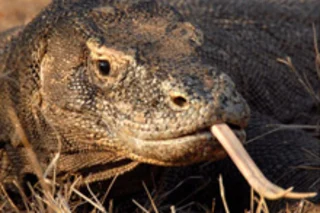The Komodo dragon has unusual hunting methods, but it generally gets its meal: The monstrous lizard, which can reach 10 feet in length, lies in wait for prey and then lunges out to deliver
a single deep bite, often to the leg or the belly. Sometimes the victim immediately falls, and the lizards can finish it off. But sometimes a bitten animal escapes. Biologists have noted that the lizard’s victims may collapse later, becoming still and quiet, and even die [The New York Times].
This delayed reaction had caused previous researchers to suggest that the dragon
kills via blood poisoning caused by the multiple strains of bacteria in the dragon's saliva. But "that whole bacteria stuff has been a scientific fairy tale," said Bryan Fry [National Geographic News]
, lead researcher in a new study. Instead, the dragon uses its sharp, serrated teeth to rend its victim's flesh while it simultaneously injects a venom that lowers the animal's blood pressure and prevents blood clotting. Says Fry:
“If you keep it bleeding and lower its blood pressure, it’s going to lose consciousness, and then you can tear its guts out at your leisure” [The New York Times].
For the new study, published in the Proceedings of the National Academy of Sciences, researchers dissected a Komodo dragon that died of natural causes at a zoo in Singapore. They found a set of six venom glands and ducts that led to the spaces between the lizard's teeth, and detected
proteins known to be in snake venom. In particular, compounds known to widen blood vessels and thin the blood — which induces shock — were present. Fry and his colleagues injected the venom into rats and confirmed that their blood pressure and aortic tension decreased. After the injection, the rats also became still, an outward sign of shock [Science News].
The venom is relatively weak, and the delivery system isn't the most efficient, comments Christofer Clement, a comparative physiologist--but it's enough to do the trick, he says.
"These lizards make a huge wound using their teeth; that's good enough to get the venom in.... They are robust enough that they can hang onto prey. Other groups like snakes are much more fragile - they have to bite something and let it go. So they have these hollow fangs and more deadly venom" [BBC News].
Related Content: 80beats: The Father of All Fangs—Snake Weapons Came From One Ancestor Discoblog: Komodo Dragons Attack Villagers; Villagers Blame Environmentalists The Loom: Venomous Dragon [Tattoo] DISCOVER: The Evolution of the DragonImage: Chris Kegelman














